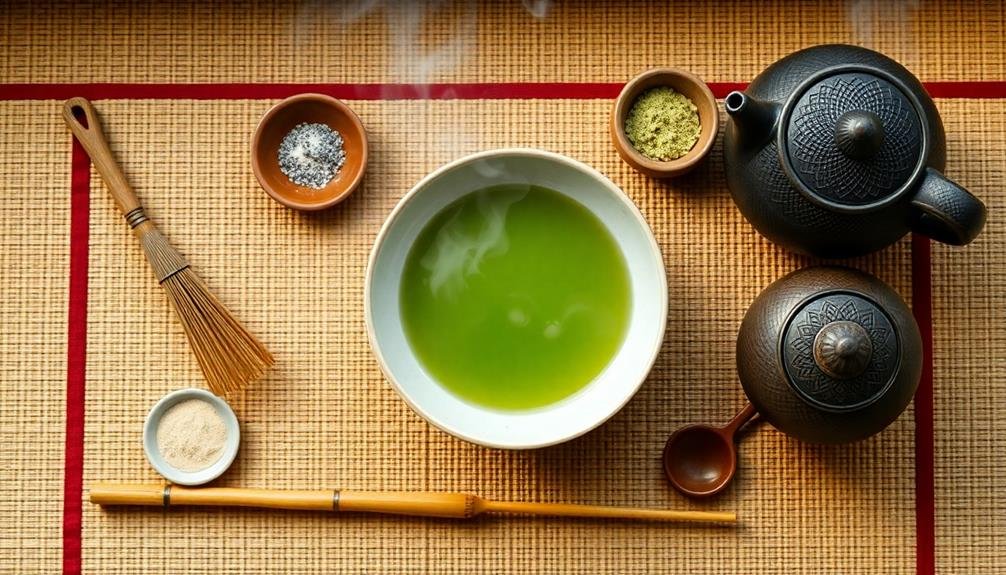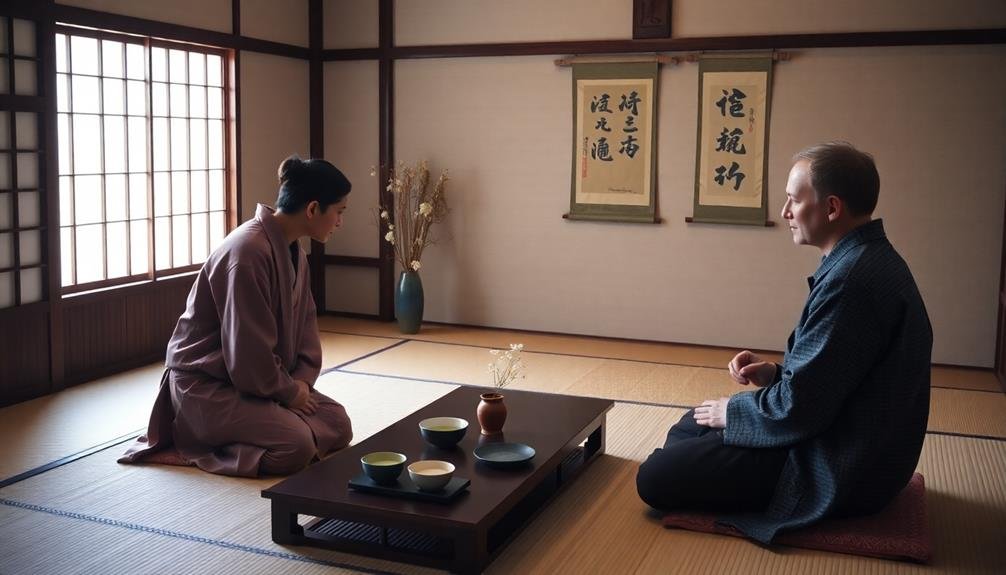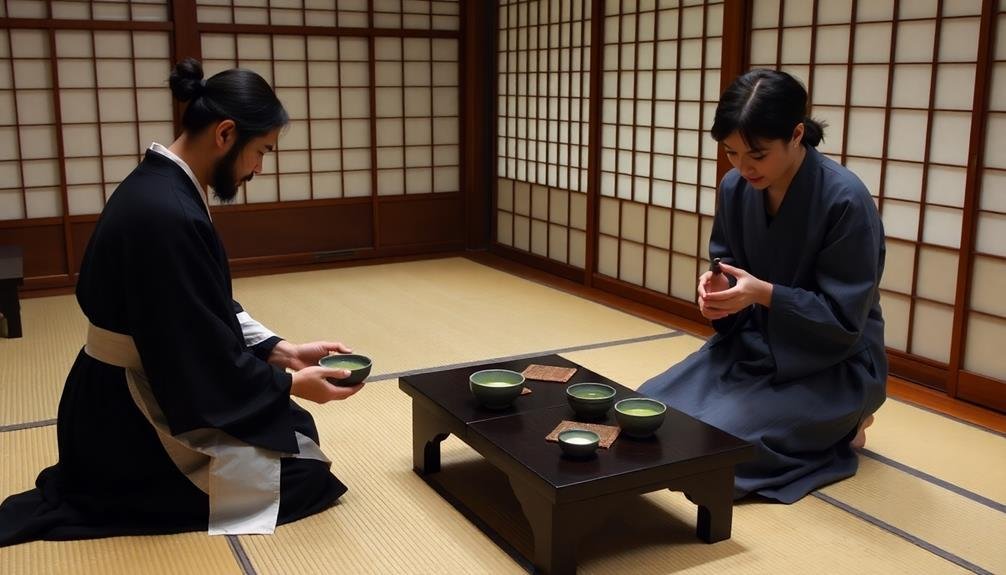The essential tea ceremony rules focus on proper preparation, attire, roles, equipment, etiquette, and mindfulness. You'll need to use high-quality tea leaves, specific utensils, and follow precise brewing techniques. Dress modestly and comfortably, avoiding flashy patterns or strong fragrances. As a guest, arrive on time and follow the host's lead. Hosts should create a harmonious atmosphere and guide the ceremony. Handle utensils with care, drink tea mindfully, and show appreciation for the experience. Practice being present in the moment and reflect on the cultural significance. Embracing these rules will deepen your understanding of this rich tradition.
Proper Tea Preparation Techniques

To kick off the tea ceremony, mastering proper tea preparation techniques is vital.
You'll need to start by selecting high-quality tea leaves appropriate for the ceremony. Choose water that's free from impurities and heat it to the correct temperature for your specific tea type.
When steeping the tea, pay close attention to timing. Green teas typically require 1-3 minutes, while black teas need 3-5 minutes. Use a timer to guarantee precision.
The water-to-tea ratio is essential; generally, use about 2 grams of tea per 100ml of water.
Handle your teaware with care and respect. Warm the teapot and cups before use by rinsing them with hot water. This practice not only cleanses the vessels but also maintains the tea's temperature.
Pour the tea with a steady hand, filling each cup equally. Be mindful of your movements, as grace and fluidity are key elements of the ceremony.
Avoid overfilling the cups; leave some space at the top.
Formal Tea Ceremony Attire
When it comes to formal tea ceremony attire, dressing appropriately is crucial for showing respect and maintaining the ceremony's traditional atmosphere.
You'll want to choose clothing that's modest, comfortable, and in line with the event's formality. For most tea ceremonies, you should opt for subdued colors and simple designs. Avoid wearing bright, flashy patterns or overly casual attire.
Women typically wear a kimono or a conservative dress, while men often don a suit or traditional Japanese clothing.
Here are some key points to remember when selecting your tea ceremony attire:
- Comfort: Choose clothing that allows you to sit comfortably on the floor for extended periods.
- Modesty: Confirm your attire covers your shoulders, chest, and legs appropriately.
- Footwear: Wear clean, easily removable socks or stockings, as you'll need to remove your shoes before entering the tea room.
Remember to remove any strong fragrances, excessive jewelry, or accessories that might distract from the ceremony.
Guest and Host Roles

In a traditional tea ceremony, you'll find distinct roles for both the host and guests.
As a host, you're responsible for preparing the tea room, selecting and serving the tea, and guiding the ceremony's flow.
If you're a guest, you'll need to follow specific etiquette rules, such as how to enter the tea room, when to bow, and the proper way to drink the tea.
Host's Duties and Responsibilities
At the heart of any successful tea ceremony lies the host's pivotal role. As the host, you're responsible for creating a harmonious atmosphere and ensuring your guests' comfort throughout the event. Your duties extend far beyond simply serving tea; you must meticulously prepare the tea room, select appropriate utensils, and choreograph the ceremony's flow.
Your responsibilities include:
- Preparation: Clean the tea room, arrange flowers, and select tea implements that complement the season and occasion.
- Tea selection and preparation: Choose high-quality tea leaves and prepare them according to traditional methods.
- Guest interaction: Greet guests warmly, guide them through the ceremony, and engage in light conversation when appropriate.
You'll need to master the art of tea preparation, including whisking matcha or steeping loose-leaf teas to perfection.
Pay close attention to your guests' needs, refilling their cups and offering sweets at the right moments.
Guest Etiquette and Expectations
Respect forms the cornerstone of guest etiquette in a tea ceremony. As a guest, you're expected to arrive on time and dress modestly, avoiding strong perfumes or flashy accessories. Before entering the tea room, remove your shoes and any outer garments. Bow slightly when crossing the threshold to show reverence for the space.
Once inside, follow the host's lead. Wait to be seated and don't touch any utensils or decorations without permission. When it's your turn to receive tea, place it in front of you and admire its appearance.
Before drinking, bow to the host and other guests, then rotate the cup 180 degrees to avoid drinking from the decorative front. Sip the tea quietly, savoring its flavor. After finishing, wipe the rim where you drank and rotate the cup back.
It's polite to request a second serving if offered. Throughout the ceremony, maintain a calm demeanor and avoid unnecessary conversation. Show appreciation for the host's efforts by complimenting the tea, sweets, or utensils.
Essential Tea Ceremony Equipment
To perform a proper tea ceremony, you'll need a specific set of traditional utensils and tools.
You must have the correct tea preparation vessels, such as the chawan (tea bowl) and chasen (tea whisk), to create the perfect matcha.
Don't forget the ceremonial decorative elements like the hanging scroll and flower arrangement, which enhance the aesthetic experience.
Traditional Utensils and Tools
The tea ceremony relies on several key utensils and tools, each serving a specific purpose in the ritual. You'll need to familiarize yourself with these traditional items to properly participate in or host a tea ceremony.
The most important utensil is the chawan, a wide-mouthed tea bowl used for preparing and drinking the matcha. You'll also need a chasen, a bamboo whisk used to mix the powdered tea with hot water, creating a smooth, frothy consistency. The chashaku, a bamboo scoop, is essential for measuring and transferring the matcha powder into the chawan.
Other vital tools include:
- Kama: A metal kettle for boiling water
- Natsume: A small container for storing matcha powder
- Fukusa: A silk cloth for cleaning utensils
You'll also need a tea caddy to hold the natsume and other small items, as well as a water jar for fresh cold water.
The tea ceremony host typically uses a waste water container called a kensui to dispose of excess water. Understanding the function and proper handling of these utensils is vital for maintaining the ceremony's flow and respecting its traditions.
Proper Tea Preparation Vessels
During a tea ceremony, proper vessels are essential for preparing and serving tea. The most important vessel is the chawan, a tea bowl used for both making and drinking the tea. It's typically ceramic and comes in various shapes and sizes, with each style suited to different seasons or tea types.
You'll also need a chaire, a small ceramic container for storing the powdered green tea (matcha). This vessel is often kept in a silk pouch called a fukusa. For scooping the tea, you'll use a chashaku, a bamboo tea scoop.
The mizusashi is a water container that holds fresh water for the ceremony. It's usually made of ceramic or porcelain. To transfer hot water from the kettle to the tea bowl, you'll use a hishaku, a long-handled bamboo ladle.
For whisking the tea, a chasen (bamboo whisk) is essential. It's used to mix the powdered tea with hot water, creating a smooth, frothy consistency.
Ceremonial Decorative Elements
Beyond the functional vessels, several decorative elements play essential roles in creating the proper atmosphere for a tea ceremony. These items contribute to the aesthetic experience and help set the mood for the ritual. You'll find that carefully chosen decorative elements enhance the ceremony's spiritual and artistic aspects.
Key ceremonial decorative elements include:
- Hanging scrolls (kakemono): These calligraphy or painting scrolls are displayed in the alcove (tokonoma) and often feature seasonal themes or philosophical messages.
- Flower arrangements (chabana): Simple, seasonal floral displays in rustic vases complement the tea ceremony's natural aesthetic.
- Incense burners (koro): These vessels emit subtle fragrances, engaging the sense of smell and creating a meditative atmosphere.
You'll also encounter other decorative items such as tea scoops (chashaku) made from bamboo or ivory, and tea caddies (natsume) for storing powdered tea.
These elements aren't merely ornamental; they're integral to the ceremony's flow and symbolism. As you participate in or host tea ceremonies, you'll learn to appreciate how these decorative elements work together to create a harmonious and contemplative environment, enhancing the overall tea experience.
Serving and Drinking Etiquette

Tea ceremony etiquette governs both the serving and drinking processes, ensuring a harmonious and respectful experience for all participants.
As a guest, you'll need to wait for the host to signal that it's time to drink. When it's your turn, bow slightly to the person next to you, then pick up the tea bowl with your right hand and place it in your left palm.
Before drinking, rotate the bowl clockwise about 45 degrees so you don't sip from the front. Take small, quiet sips and avoid slurping. It's customary to compliment the tea's taste and appearance. When finished, wipe the rim where you drank with your right hand, rotate the bowl back, and return it to its original position.
If you're serving, handle the tea utensils with care and deliberation. Present the tea bowl to each guest with its front facing them. When collecting used bowls, turn them so the front faces you before picking them up.
Throughout the ceremony, maintain a sense of calm and mindfulness. Your movements should be graceful and unhurried, reflecting the meditative nature of the tea ceremony.
Mindfulness and Appreciation Practices
Tranquility forms the heart of tea ceremony mindfulness practices. As you participate in the ceremony, focus on being present in the moment, letting go of external concerns.
Engage your senses fully: observe the colors and textures of the tea utensils, inhale the aroma of the tea, and savor its taste. This mindful approach allows you to appreciate the subtle nuances of the tea and the artistry of the ceremony.
Practice gratitude throughout the ceremony. Express appreciation for the host's efforts, the beauty of the surroundings, and the company of fellow participants.
Reflect on the cultural significance and history of the tea ceremony, acknowledging its role in fostering harmony and respect.
To deepen your mindfulness and appreciation:
- Take slow, deliberate breaths to center yourself
- Silently acknowledge each action and object in the ceremony
- Contemplate the impermanence of the moment, enhancing your appreciation
Frequently Asked Questions
How Long Does a Traditional Tea Ceremony Typically Last?
You'll typically spend about 4 hours at a traditional tea ceremony. It's a leisurely experience, with each step carefully performed. Don't rush; you'll savor every moment, from the room's preparation to the final sip of tea.
Are There Different Types of Tea Ceremonies Across Various Cultures?
You'll find diverse tea ceremonies across cultures. From Japan's formal chanoyu to China's gongfu cha, and Britain's afternoon tea, each tradition has unique rituals. You'll encounter varying customs, equipment, and tea types in different ceremonies worldwide.
Can Children Participate in Formal Tea Ceremonies?
Yes, you can include children in formal tea ceremonies. You'll need to teach them proper etiquette and expectations beforehand. They can participate in simpler roles or observe quietly. It's a great way to introduce cultural traditions.
What Is the Significance of the Tea Room's Layout and Design?
You'll find the tea room's layout and design deeply symbolic. It's purposefully simple, creating a tranquil atmosphere. You'll notice carefully placed elements like the tokonoma alcove, which reflects the host's aesthetic sensibility and the ceremony's seasonal theme.
Are There Health Benefits Associated With Participating in Tea Ceremonies Regularly?
You'll experience numerous health benefits from regular tea ceremonies. You'll reduce stress, improve mindfulness, and boost your immune system. You'll also enhance social connections, lower blood pressure, and enjoy antioxidants from the tea you're consuming.
In Summary
You've now learned the core rules of a tea ceremony. Remember, it's about more than just drinking tea. It's a mindful practice that celebrates tradition and respect. As you participate, focus on each moment, from the careful preparation to the final sip. Whether you're a host or guest, your role is essential. By following these guidelines, you'll honor the ceremony's spirit and create a truly meaningful experience for all involved.





Leave a Reply